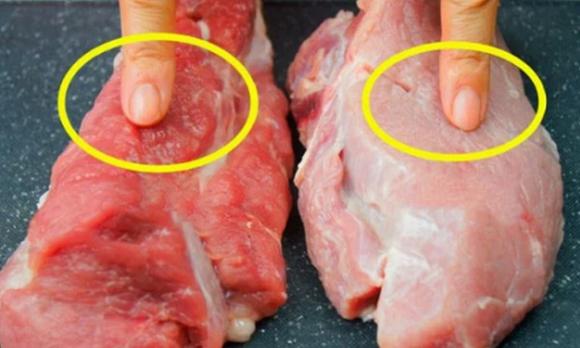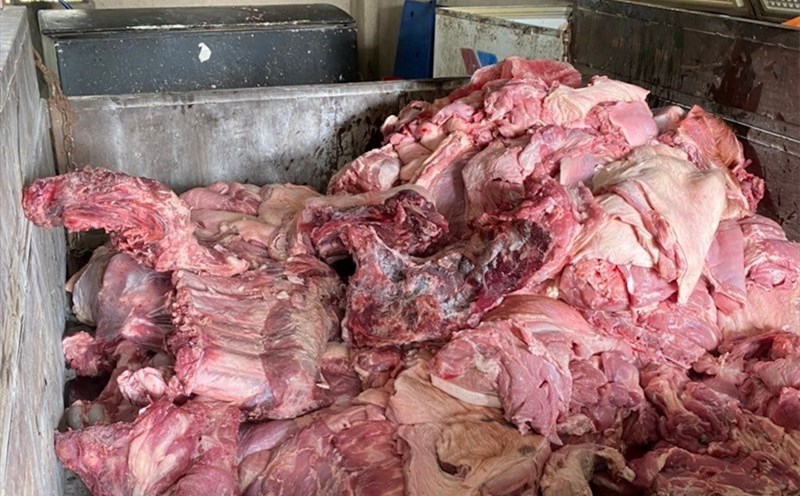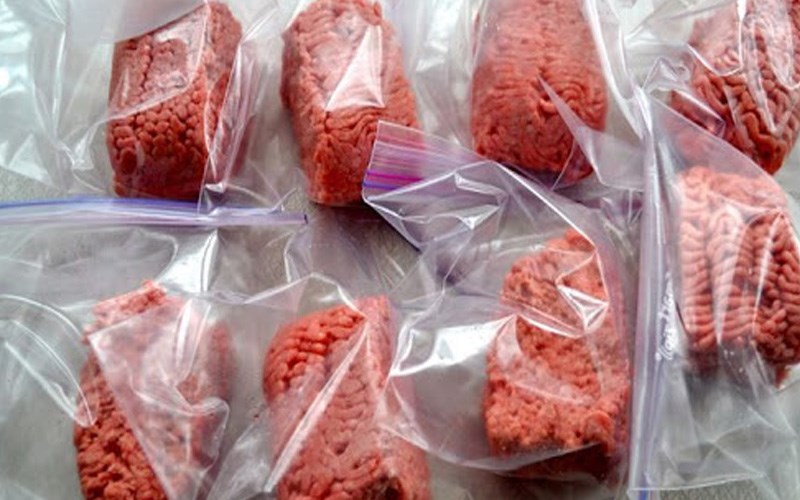Consuming stale pork is not only a waste of money but can also lead to serious health issues. Here are five tell-tale signs to help you identify spoiled pork and enable you to make healthier choices by opting for fresh and safe alternatives.
Abnormal Meat Color
The color of the meat can be a good indicator of its freshness. Fresh pork usually ranges from light pink to bright red. If you notice the meat turning gray, green, or developing odd-colored spots, it’s a clear sign that the pork has gone bad and is no longer safe to consume.
However, it’s important to note that color isn’t always the determining factor. The change in color could be due to oxidation if the package isn’t sealed properly, allowing air to get in. While oxidation is a natural process, prolonged exposure to air can lead to spoilage.

Meat color can indicate its freshness.
Slimy and Sticky Texture
A slimy and sticky surface on pork is a significant indicator of bacterial growth. If not stored properly, pork can become a favorable environment for bacteria to thrive. As bacteria grow, they initiate the process of meat decomposition. During this process, proteins in the meat break down, leading to the formation of slime, rendering the meat unsafe for consumption.
Unpleasant Odor
An offensive odor emanating from the meat is a warning sign that it has gone bad. Fresh pork usually has a mild and distinctive smell that isn’t too strong. However, if you detect any rancid, putrid, fishy, or unusual odors, it’s a clear indication that the meat has spoiled. Be cautious and don’t hesitate to discard such meat, no matter how attractive the price may be.

Unpleasant odors are a warning sign that the meat is no longer fresh.
Loss of Elasticity
Fresh pork typically has a distinct elasticity. When you gently press on its surface, it should immediately bounce back to its original form. If you find that the meat has lost its elasticity, becoming soft or indented without recovery, it’s a sign that the pork is either old or spoiling.
Swollen Packaging
Swollen packaging is a clear indication that the meat has likely exceeded its expiration date and is unsafe to consume. In a sealed package, harmful bacteria can grow, especially if the meat isn’t stored at the right temperature. The bacterial decomposition process produces gas, leading to swollen packaging.

Swollen packaging indicates that the meat is likely past its expiration date.
Potential Health Risks of Consuming Spoiled Pork:
– Food Poisoning: Spoiled pork may contain harmful bacteria such as Salmonella, E. coli, or Staphylococcus aureus, leading to food poisoning symptoms, including nausea, vomiting, diarrhea, abdominal pain, and fever.
– Parasitic Infection: Certain parasites can live in pork and cause health issues if the meat isn’t thoroughly cooked.
To ensure food safety, consider the following precautions:
– Inspect the packaging: Before purchasing, carefully examine the packaging to ensure it isn’t torn, punctured, or swollen.
– Check the expiration date: Make sure the pork is within its expiration date and has been stored at the appropriate temperature.
– Choose a reputable source: Purchase pork from trusted stores or supermarkets that maintain high standards of hygiene and food safety.
The Perfect Pork Promise: How to Ensure You’re Buying the Best Bacon.
When it comes to pork, it’s important to be mindful of the quality and freshness of the meat you’re purchasing. While you may be tempted to grab a bargain, it’s best to steer clear of pork that exhibits any of these five warning signs. Doing so will not only save you money but also protect your health.
The Ultimate Guide to Pork Shopping: Master the “1 Remember, 3 Forget” Rule for Choosing Clean Meat
 Pork Shopping: Master the “1 Remember, 3 Forget” Rule for Choosing Clean Meat’>
Pork Shopping: Master the “1 Remember, 3 Forget” Rule for Choosing Clean Meat’>When shopping for pork, it’s essential to keep an eye out for these tell-tale signs to ensure you’re not buying low-quality meat. By being vigilant, you can avoid the risk of purchasing spoiled or water-injected pork and keep yourself and your family safe from potential health hazards.
The Ultimate Guide to Buying Fresh Mushrooms: Heed These 4 Tips to Avoid Costly Mistakes
Introducing the ultimate guide to purchasing shiitake mushrooms safely and wisely. There are indeed hidden dangers in buying shiitake mushrooms, and being unaware of them can be detrimental to your health and wallet. With that in mind, we’ve crafted this insightful article to unveil the four critical considerations you must keep in mind when selecting shiitake mushrooms. Get ready to become a savvy shopper as we explore the essential factors that will ensure a safe and satisfying shiitake experience!





































